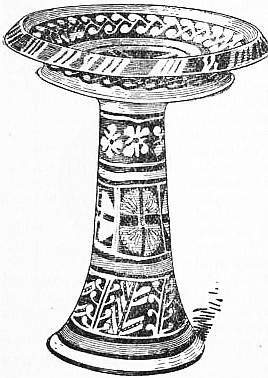and often careless, and the general effect gaudy; subjects funereal, theatrical and fanciful. At the end of this period vases are largely replaced by plain shining black pottery modelled in various forms, or with decorations in relief, all these being imitations of the metal vases which began to take the place of painted wares in the estimation of the Hellenistic world.
I. Vases of the Primitive Period.—It has been noted in the introductory section that it is possible to trace the development of pottery in Greece as far back as the Neolithic period, owing chiefly to the light recently thrown on the subject by the excavations in Crete. These have yielded large quantities of painted pottery of high technical merit, usually with decoration in polychrome or white on a dark ground, in what is known as the Kamares ware, covering the period 2500–1500 B.C. (fig. 20). This was gradually superseded by painting in dark shining pigments on a light glossy ground during the later Minoan period (1500–1000 B.C.), forming what is known as the “Mycenaean” style. The subjects, though chiefly confined to floral ornaments or aquatic plants and creatures, are marvellously naturalistic yet decorative in their treatment, often rivalling in this respect the pottery of the Far East. In the latter part of this period this class of pottery was spread all over the Mediterranean, and large quantities have been found in Greece, especially at Mycenae, in Rhodes and other Greek islands, and in Cyprus, where a series of vases with animals, monsters, and even human figures shows what is probably the latest development of the pure Minoan or Mycenaean style.
Outside Crete the earliest Greek pottery has been found in Cyprus and at Troy, with simple incised or painted patterns on a black polished ground, the vases being all hand-made, and often treated in a plastic fashion with rude modelling of human or animal forms (figs. 21, 22); these cover the period 2500-2000 B.C. Early painted pottery, parallel with the Kamares ware, has been found in Thera and in the important cemeteries of Phylakopi in Melos. But until the general spread of Mycenaean civilization and art in the latter half of the second millennium there is no site except Crete where a continuous and successful development can be studied.
 |
| Fig. 22.—Primitive red pottery from the Troad. |
About the time which is represented in Greek tradition by the Dorian invasion (1100 B.C.) the then decadent Mycenaean civilization was replaced by a new one much more backward in development, making pottery of a far simpler and more conventional type, the decoration being largely confined to geometrical patterns to the exclusion of motives derived from plant forms. This is usually known as the geometrical style, and the pottery covers the period from about 1000 to 700 B.C. It is found all over the mainland and islands of Greece, and exhibits a certain development towards a more advanced stage. The patterns include the chevron, the triangle, the key or maeander, and the circle, in various combinations, painted in dull black on a brown ground. In most places the art advanced no further, but in Boeotia, and still more at Athens, we can trace the gradual growth of decorative skill, first in the introduction of animals, and then in the appearance of the human figure. In the Athenian cemetery outside the Dipylon gate a series of colossal vases has come to light, on which are painted such subjects as sea-fights and funeral processions. The human figures are exceedingly rude and conventional, painted almost entirely in silhouette, but there is a distinct striving after artistic effect in the composition and arrangement. In Boeotia the vases do not advance beyond the animal stage, and many exhibit a tendency to decadence in their carelessness, as contrasted with the painstaking helplessness of the Athenian artists.
 |
| Fig. 24.—Ionic amphora, with contest between Heracles and Hera, and bands of birds and animals; black, with incised lines. |
In Ionia and the islands of the Aegean such as Rhodes, the art of vase-painting from the first carried on the Mycenaean tradition, and was distinguished by its naturalism and originality, and by the bold and diverse effects produced by variety of colour or novelty of subject. The ornamentation is at first elementary, consisting of friezes of animals, especially lions, deer and goats (figs. 23 and 24). These figures stand out sharply in black against the creamy buff ground which is characteristic of nearly all Ionic pottery, and details are brought out by means of engraved lines, patches of purplish iron pigment, or by drawing parts of the figures, especially the heads, in outline on the clay ground. Another feature is the general use of small ornaments such as rosettes and crosses in great variety of form to cover



